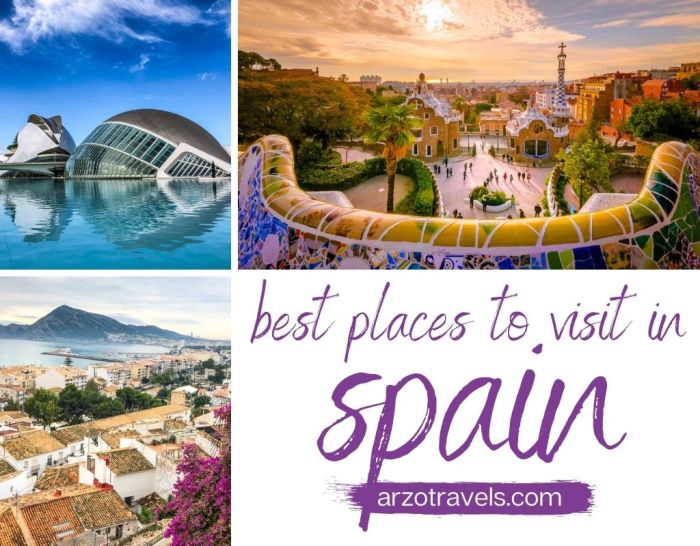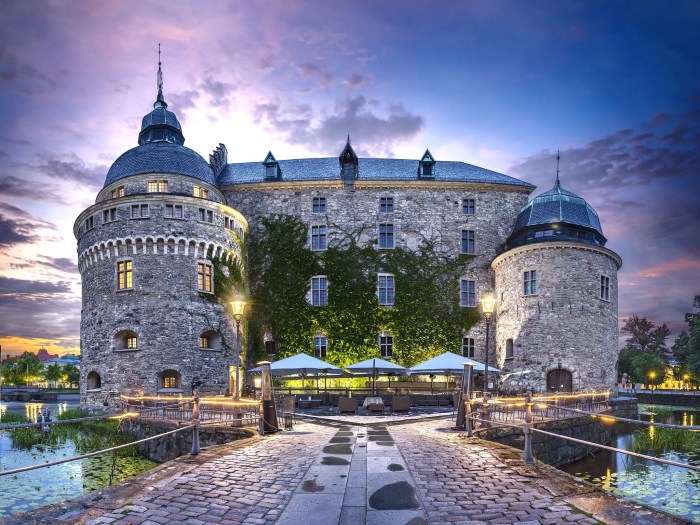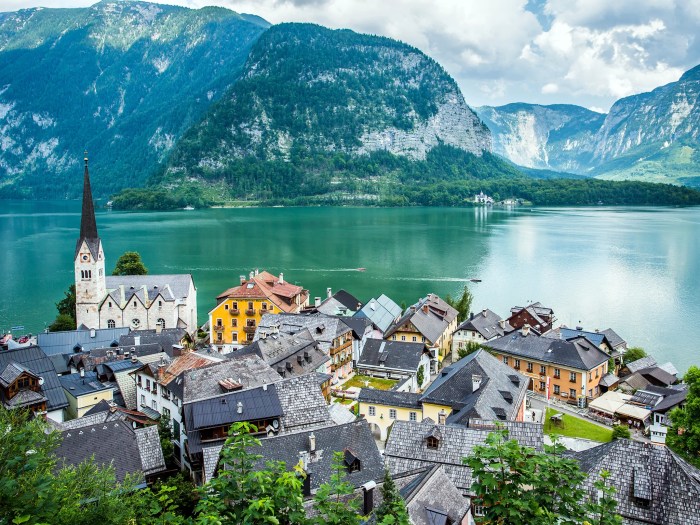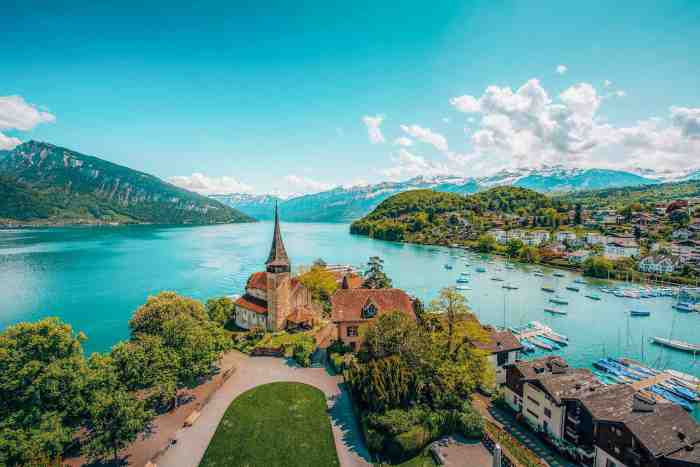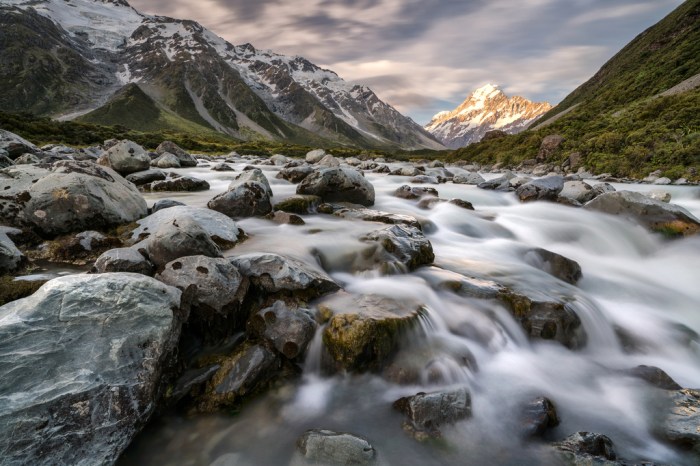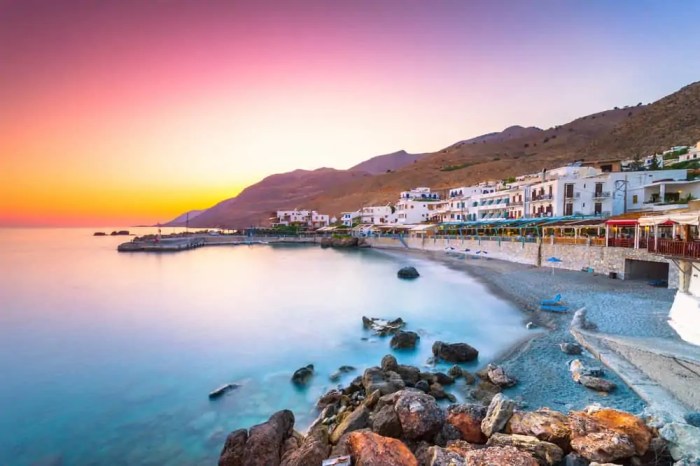Top 30 Places In The Alps
Top 30 Places In The Alps: From snow-capped peaks to charming villages, the Alps offer an incredible range of experiences. Whether you’re an adrenaline junkie seeking epic hikes and ski slopes or a culture enthusiast drawn to ancient castles and traditional festivals, the Alps have something for everyone.
This guide dives into the heart of the Alps, exploring iconic peaks, cultural gems, and outdoor adventures. We’ll journey through charming towns and villages, savor culinary delights, and uncover hidden gems that will leave you wanting more. Get ready to discover the magic of the Alps!
Introduction
The Alps, a majestic mountain range spanning across eight European countries, are a testament to nature’s grandeur and a cultural melting pot. They are a geological marvel, shaping the landscape and influencing the lives of millions. This guide explores the top 30 places in the Alps, showcasing the diverse experiences they offer, from breathtaking natural wonders to charming villages and thrilling outdoor adventures.
Criteria for Selection
The selection of the top 30 places in the Alps is based on a multifaceted approach, considering a range of factors, including:
- Natural Beauty:The Alps boast stunning scenery, including towering peaks, pristine lakes, lush meadows, and glaciers. The selection prioritizes places with exceptional natural beauty.
- Cultural Significance:The Alps are home to a rich tapestry of cultures, traditions, and history. The selection includes places that reflect this cultural heritage, such as historical sites, traditional villages, and cultural events.
- Outdoor Activities:The Alps are a paradise for outdoor enthusiasts, offering a wide array of activities, including hiking, skiing, climbing, and cycling. The selection includes places that cater to these activities.
- Accessibility and Infrastructure:The selection prioritizes places that are easily accessible and offer adequate infrastructure, such as transportation, accommodation, and amenities.
Allure of the Alps
The Alps beckon travelers with their unparalleled natural beauty, offering a sanctuary for those seeking solace in nature. The towering peaks, glistening glaciers, and emerald valleys create a breathtaking panorama, leaving a lasting impression on visitors. The Alps also provide a playground for outdoor enthusiasts, with endless opportunities for hiking, skiing, climbing, and cycling.
The diverse landscape, from alpine meadows to glacial valleys, caters to all levels of experience. Beyond the natural beauty, the Alps are steeped in cultural richness, with charming villages, traditional festivals, and historical sites. The region’s unique culinary traditions, vibrant arts scene, and welcoming hospitality add to the allure of this destination.
Iconic Peaks and Landscapes
The Alps are renowned for their majestic peaks, stunning landscapes, and unique geological formations. From towering summits to pristine glaciers, the region offers a diverse array of natural wonders that have captivated travelers and mountaineers for centuries.
The Most Famous Peaks
The Alps are home to some of the highest and most iconic peaks in Europe. These peaks have inspired countless stories, legends, and mountaineering expeditions.
- Mont Blanc: The highest peak in the Alps, Mont Blanc rises to a majestic 4,808 meters (15,777 feet). Its imposing presence has attracted climbers and adventurers for centuries. Its name, meaning “White Mountain,” aptly describes its snow-capped summit.
- Matterhorn: Known for its distinctive pyramid shape, the Matterhorn is a symbol of the Swiss Alps. Reaching a height of 4,478 meters (14,692 feet), it has a long history of mountaineering, with the first successful ascent in 1865.
- Eiger: Located in the Bernese Oberland, the Eiger is renowned for its sheer north face, which has been a formidable challenge for climbers for decades. The “Eigerwand” (Eiger Wall) has claimed the lives of many climbers, earning it the nickname “Murder Wall.”
- Jungfrau: Meaning “Virgin,” the Jungfrau is a 4,158-meter (13,642-foot) peak in the Bernese Alps. Its summit is accessible by train, offering breathtaking views of the surrounding mountains and glaciers.
Geological Formations and Landscapes
The Alps boast a diverse range of geological formations and landscapes, shaped over millions of years by tectonic activity, erosion, and glacial movement.
- Glaciers: The Alps are home to numerous glaciers, which play a vital role in shaping the landscape. These massive ice formations carve out valleys, create U-shaped valleys, and deposit glacial moraines.
- Alpine Lakes: The Alps are dotted with picturesque lakes, many of which were formed by glacial erosion. These lakes offer stunning reflections of the surrounding mountains and provide opportunities for boating, swimming, and fishing.
- Mountain Passes: The Alps have numerous mountain passes, which have historically served as important trade routes and strategic points. These passes offer breathtaking views and are popular for hiking and cycling.
- Karst Formations: In some parts of the Alps, limestone formations have been sculpted by water, creating caves, sinkholes, and other karst features. These formations are fascinating examples of the power of nature to create unique landscapes.
The Impact of Glaciers
Glaciers are essential components of the Alpine ecosystem, playing a significant role in shaping the landscape and influencing the region’s climate. However, they are facing unprecedented challenges due to climate change.
- Glacial Retreat: Global warming has led to a significant retreat of glaciers in the Alps. As temperatures rise, glaciers melt at an accelerated rate, causing a decrease in their size and volume.
- Water Resources: Glaciers act as natural reservoirs, storing vast amounts of water. Their retreat has implications for water availability, potentially affecting agricultural production, hydropower generation, and drinking water supplies.
- Landslide Risk: As glaciers retreat, they expose slopes that are vulnerable to landslides and rockfalls. This poses a risk to infrastructure, communities, and tourism.
- Biodiversity: Glaciers support unique ecosystems and species adapted to cold environments. Their retreat threatens the survival of these species and the biodiversity of the Alpine region.
Cultural Gems
The Alps are not just a breathtaking natural wonder; they are also a treasure trove of cultural heritage, shaped by the people who have called this region home for centuries. From ancient castles to vibrant festivals, the Alps offer a glimpse into a rich and diverse past.
Historical Sites
The Alps are dotted with historical sites that tell the story of their past. These sites offer a window into the region’s rich history, from Roman settlements to medieval castles.
- The Roman City of Aosta: Founded in 25 BC by the Romans, Aosta is a testament to the region’s strategic importance. The city’s Roman ruins, including the Arch of Augustus and the Roman Theatre, are well-preserved and offer a fascinating glimpse into the Roman Empire’s influence on the Alps.
- The Medieval Castles of the Alps: Throughout the Alps, you’ll find numerous medieval castles, each with its own unique history. These castles were built for defense and to control strategic mountain passes. Some notable examples include the Castle of Chillon in Switzerland, the Castle of Neuschwanstein in Germany, and the Castle of Chambéry in France.
- The Abbey of St. Gallen: This UNESCO World Heritage Site is a stunning example of Benedictine architecture. Founded in the 7th century, the abbey has been a center of learning and culture for centuries. The abbey’s library, with its vast collection of manuscripts, is a treasure trove of knowledge.
Traditions and Folklore
The people of the Alps have a unique culture, shaped by their environment and their history. This culture is reflected in their traditions, folklore, and way of life.
- Alpine Folklore: The Alps are rich in folklore, with stories of mythical creatures, magical beings, and ancient legends. The stories of the “Krampus” in Austria and the “Schwyzerörgeli” in Switzerland are just a few examples of the rich folklore that has been passed down through generations.
- Alpine Music and Dance: The music and dance of the Alps are an integral part of the region’s culture. From the yodeling of the Swiss Alps to the traditional folk music of the Austrian Tyrol, the music of the Alps is often characterized by its lively rhythms and heartfelt melodies.
- Alpine Cuisine: The cuisine of the Alps is simple, hearty, and based on local ingredients. Dishes like “fondue” in Switzerland, “Käsespätzle” in Germany, and “Polenta” in Italy are just a few examples of the delicious and unique cuisine of the Alps.
Art, Music, and Literature
The Alps have inspired artists, musicians, and writers for centuries. Their beauty and grandeur have been captured in paintings, songs, and stories.
- Alpine Painting: The Alps have been a popular subject for artists for centuries. From the Romantic landscapes of Caspar David Friedrich to the impressionist paintings of Claude Monet, the Alps have inspired artists to capture their beauty and grandeur on canvas.
- Alpine Music: The music of the Alps is as diverse as the region itself. From the classical compositions of Mozart and Beethoven to the traditional folk music of the Alps, the region’s music reflects its unique cultural heritage.
- Alpine Literature: The Alps have also inspired writers, from the Romantic poets of the 19th century to the contemporary authors of today. The works of Johann Wolfgang von Goethe, Ernest Hemingway, and James Joyce are just a few examples of the many books that have been inspired by the Alps.
Outdoor Adventures
The Alps are a playground for outdoor enthusiasts, offering a wide range of activities for all skill levels and interests. Whether you’re seeking adrenaline-pumping thrills or peaceful escapes in nature, the Alps have something for everyone.
Hiking
Hiking is one of the most popular activities in the Alps, with trails ranging from gentle strolls to challenging climbs.
- Easy:The Eiger Trailin Switzerland offers stunning views of the Eiger, Mönch, and Jungfrau mountains. It’s a relatively easy hike with well-maintained paths, perfect for families with children.
- Moderate:The Tour du Mont Blancis a multi-day trek that circles the highest peak in Western Europe. It’s a challenging but rewarding hike with breathtaking scenery and diverse landscapes.
- Difficult:The Via Ferratain Italy offers a unique and thrilling experience, combining hiking with climbing. These protected routes use ladders, cables, and bridges to traverse steep cliffs and rocky terrain.
Skiing
The Alps are home to some of the world’s best ski resorts, offering a wide range of slopes for all abilities.
- Beginner: Courchevelin France is a renowned resort with gentle slopes and wide pistes, perfect for beginners. It also offers a wide range of ski schools and instructors.
- Intermediate: Zermattin Switzerland is a picturesque village with challenging slopes and stunning views of the Matterhorn. It’s a popular destination for intermediate skiers looking for a challenging yet scenic experience.
- Advanced: Chamonixin France is a legendary resort known for its steep slopes and off-piste terrain. It attracts experienced skiers and snowboarders seeking adrenaline-pumping adventures.
Climbing
The Alps offer a variety of climbing opportunities, from easy scrambles to challenging multi-pitch routes.
- Easy:The Dolomitesin Italy are known for their limestone cliffs and numerous via ferratas, perfect for beginners and those seeking a safe and accessible climbing experience.
- Moderate:The French Alpsoffer a wide range of climbing routes, ranging from traditional climbing to sport climbing. The area is popular for its variety of routes and beautiful scenery.
- Difficult:The Swiss Alpsare home to some of the most challenging climbs in the world, including the North Face of the Eiger, a notorious and highly technical route.
Cycling
Cycling is a popular way to explore the Alps, with scenic routes ranging from gentle bike paths to challenging mountain passes.
- Easy:The Lake Constance Cycle Pathin Germany, Austria, and Switzerland is a scenic route that follows the shores of Lake Constance. It’s a relatively flat route, perfect for families and leisurely rides.
- Moderate:The Stelvio Passin Italy is one of the highest paved mountain passes in Europe. It’s a challenging climb with stunning views of the surrounding mountains.
- Difficult:The Tour de Franceroute includes some of the most challenging climbs in the Alps, such as the Alpe d’Huezand the Col du Galibier. These routes are only recommended for experienced cyclists.
Environmental Impact
Tourism in the Alps has a significant impact on the environment. To minimize this impact, it’s important to practice sustainable travel and responsible tourism.
- Reduce your carbon footprint:Travel by train or bus whenever possible, and consider offsetting your carbon emissions for flights.
- Respect the environment:Stay on designated trails, pack out all trash, and avoid disturbing wildlife.
- Support local businesses:Choose eco-friendly accommodations and restaurants that promote sustainable practices.
Culinary Delights
The Alps, a region known for its breathtaking landscapes, also boasts a rich culinary tradition deeply rooted in its history and environment. From hearty mountain dishes to delectable desserts, the Alpine cuisine offers a unique and flavorful experience.
Alpine Cuisine: A Symphony of Flavors, Top 30 Places In The Alps
The cuisine of the Alps is characterized by its use of fresh, local ingredients, reflecting the region’s agricultural heritage. The high altitude and cold climate have shaped the local produce, resulting in robust flavors and textures. Alpine dishes are often simple yet satisfying, showcasing the natural bounty of the region.
Popular Dishes and Beverages
- Fondue:A quintessential Alpine dish, fondue is a melted cheese pot served with bread cubes for dipping. The cheese used in fondue varies depending on the region, but common varieties include Gruyère, Emmental, and Vacherin. Fondue is a social experience, enjoyed by sharing the pot and dipping bread with friends and family.
- Raclette:Another popular cheese-based dish, raclette involves melting a wheel of cheese over a heat source and scraping the melted cheese onto potatoes, bread, or other accompaniments. Raclette is often served with cured meats, pickles, and other traditional Alpine delicacies.
- Rösti:A crispy potato pancake, rösti is a staple dish in the Alps. It is made with grated potatoes, fried until golden brown and crispy. Rösti can be served as a side dish or as a main course with various toppings, such as bacon, mushrooms, or onions.
- Zopf:A braided bread loaf, zopf is a traditional Swiss breakfast bread. It is made with flour, yeast, milk, and eggs, and often flavored with sugar, raisins, or nuts. Zopf is typically served with butter or jam.
- Schnitzel:A thin, breaded, and fried cutlet of meat, schnitzel is a popular dish throughout the Alps. It is often made with veal, pork, or chicken, and served with a variety of sauces, including lemon, mushroom, or paprika.
- Apple Strudel:A sweet pastry filled with apples, raisins, and cinnamon, apple strudel is a beloved dessert in the Alps. It is made with thin, flaky dough and often served with vanilla sauce or whipped cream.
- Kirschwasser:A clear, colorless fruit brandy made from cherries, kirschwasser is a popular alcoholic beverage in the Alps. It is often enjoyed neat or used as an ingredient in cocktails.
- Jägertee:A warm, spiced beverage made with red wine, black tea, and spices, Jägertee is a popular winter drink in the Alps. It is often served with a shot of rum or schnapps.
Charming Towns and Villages
The Alps are not only a haven for breathtaking natural beauty but also home to a collection of charming towns and villages that hold centuries of history, rich culture, and a unique sense of community. These settlements, often nestled amidst towering peaks and lush valleys, offer a glimpse into the traditional way of life that has shaped the region for generations.
Towns and Villages of the Alps
The Alps boast a diverse range of charming towns and villages, each with its own distinctive character and allure. These settlements offer a glimpse into the traditional way of life that has shaped the region for generations.
- Hallstatt, Austria: Nestled on the shores of Lake Hallstatt, this UNESCO World Heritage Site is a picture-perfect village with traditional wooden houses, a charming lakeside promenade, and stunning mountain views. Its rich history dates back to the Iron Age, and the village is renowned for its salt mines, which have been in operation for centuries.
- Annecy, France: Known as the “Venice of the Alps,” Annecy is a picturesque town located on the shores of Lake Annecy. Its charming old town is a labyrinth of narrow streets lined with colorful buildings, canals, and bridges. The town is also a popular destination for water sports, hiking, and cycling.
- Zermatt, Switzerland: Situated at the foot of the Matterhorn, Zermatt is a car-free village renowned for its stunning mountain scenery. The village is a popular destination for skiing, snowboarding, and hiking, and its charming wooden chalets and traditional architecture create a truly idyllic atmosphere.
- Cortina d’Ampezzo, Italy: This elegant town in the Dolomites is a world-renowned ski resort, known for its luxury hotels, chic boutiques, and vibrant nightlife. The town also boasts a rich history and culture, with a charming historic center and a number of museums and art galleries.
- Innsbruck, Austria: Nestled in the heart of the Austrian Alps, Innsbruck is a bustling city with a rich history and a vibrant cultural scene. The city is known for its stunning architecture, including the Golden Roof, the Imperial Palace, and the Hofburg Palace.
The Alps are awesome, but if you’re looking for something a little more tropical, you should check out Bora Bora! It’s a total paradise, and you can find out all the best spots and things to do by checking out this awesome list: Top Places and Things To Do in Bora Bora.
After all that sun and sand, you’ll be ready to hit the slopes in the Alps again!
- Chamonix, France: Situated at the foot of Mont Blanc, Chamonix is a world-renowned mountaineering and skiing destination. The town is known for its stunning mountain scenery, its challenging slopes, and its lively après-ski scene.
- Grindelwald, Switzerland: Nestled in the Bernese Oberland region, Grindelwald is a charming village surrounded by towering mountains, including the iconic Eiger, Mönch, and Jungfrau peaks. The village is a popular destination for skiing, hiking, and enjoying the breathtaking views.
- Garmisch-Partenkirchen, Germany: Located in the Bavarian Alps, Garmisch-Partenkirchen is a popular destination for winter sports and hiking. The town is known for its traditional Bavarian architecture, its lively atmosphere, and its stunning mountain scenery.
- Interlaken, Switzerland: Situated between Lake Thun and Lake Brienz, Interlaken is a popular tourist destination known for its stunning mountain views, its vibrant atmosphere, and its wide range of activities, including hiking, biking, and water sports.
Travel Tips and Recommendations: Top 30 Places In The Alps
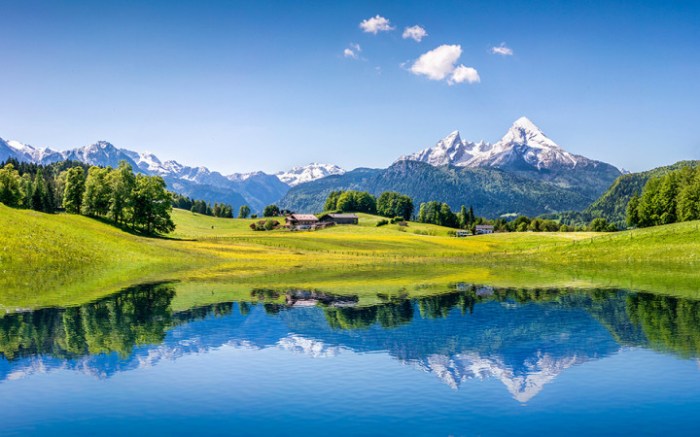
Planning a trip to the Alps can be an exciting adventure, but it’s important to be prepared. This section provides practical tips and recommendations for making the most of your alpine experience.
Transportation
Getting around the Alps can be done in various ways, each with its own advantages and disadvantages.
- Train:Trains are a scenic and efficient way to travel between major cities and towns in the Alps. They are also a good option for those who want to minimize their carbon footprint. The Swiss railway system, for instance, is renowned for its punctuality and scenic routes.
- Bus:Buses are a more budget-friendly option than trains, but they can be slower and less frequent. They are often used for shorter journeys within towns or regions.
- Car:Driving offers flexibility and the ability to explore remote areas. However, mountain roads can be narrow, winding, and challenging to navigate. It’s essential to be a confident driver and check weather conditions before embarking on any long drives.
- Helicopter:For a truly unique experience, consider a helicopter tour. This option allows you to see the Alps from a bird’s eye view, providing breathtaking panoramic views of iconic peaks and glaciers.
Accommodation
The Alps offer a wide range of accommodation options to suit every budget and preference.
The Alps are seriously stunning, and there’s no shortage of places to explore, with tons of hidden gems and famous spots. You’ve got glaciers, peaks, valleys, and more, making it hard to pick just 30 places! But if you’re looking for even more epic natural wonders, check out the Top 25 Natural Wonders Of The World list for a wider view of what our planet has to offer.
Then, get back to planning your Alps trip—you’ll be blown away by the views!
- Hotels:From luxurious five-star hotels to cozy boutique hotels, you’ll find a range of options in major towns and cities.
- Apartments:Apartments offer more space and independence, often with kitchens and laundry facilities. They are a popular choice for families or groups traveling together.
- Hostels:Budget-conscious travelers will find hostels a great option, providing shared rooms and communal spaces for socializing.
- Guesthouses:Guesthouses offer a charming and intimate experience, often run by local families and providing a taste of local culture.
- Camping:Camping is a popular choice for outdoor enthusiasts, offering the opportunity to immerse yourself in nature and enjoy stunning views.
Budgeting
The cost of a trip to the Alps can vary greatly depending on your travel style, accommodation choices, and activities.
- Accommodation:Accommodation costs can range from budget-friendly hostels to luxury hotels.
- Transportation:Train fares can be expensive, especially in Switzerland, but consider travel passes for cost savings.
- Food:Meals can be relatively affordable, especially if you opt for local restaurants or cafes.
- Activities:Activities like skiing, hiking, and mountain biking can incur additional costs, such as lift tickets or equipment rentals.
Best Time to Visit
The best time to visit the Alps depends on your interests and preferences.
- Summer (June-August):Summer offers warm weather, perfect for hiking, biking, and enjoying outdoor activities. It’s also the peak season, so expect higher prices and crowds.
- Autumn (September-October):Autumn brings vibrant fall foliage, making it a scenic time to visit. The weather is still mild, but expect cooler temperatures and occasional rain.
- Winter (December-February):Winter is the prime time for skiing and snowboarding. Expect snowy conditions and colder temperatures.
- Spring (March-May):Spring offers a mix of weather conditions, with snow melting and wildflowers blooming. It’s a good time for hiking and enjoying the transition from winter to summer.
Making the Most of Your Trip
To maximize your alpine experience, consider these tips:
- Plan ahead:Research your destination, book accommodations, and plan activities in advance, especially during peak season.
- Embrace the outdoors:Hike through scenic trails, go skiing or snowboarding in the winter, or enjoy a bike ride along picturesque mountain passes.
- Indulge in local culture:Visit charming towns and villages, sample traditional cuisine, and learn about the region’s history and heritage.
- Take advantage of transportation options:Utilize trains, buses, or cable cars to explore different areas and enjoy breathtaking views.
- Don’t forget the essentials:Pack appropriate clothing for the weather, comfortable shoes for hiking, and any necessary gear for your activities.
The Alps Through the Lens
The Alps, with their towering peaks, pristine glaciers, and verdant valleys, have long captivated the human imagination. From ancient myths and legends to modern-day photography and filmmaking, these majestic mountains have inspired countless artists, writers, and adventurers. Through the lens, we can experience the raw beauty of the Alps, their cultural heritage, and the resilience of the people who call them home.
Capturing the Essence of the Alps
Photography and filmmaking have played a crucial role in showcasing the splendor of the Alps. Renowned photographers like Ansel Adams and Vittorio Sella captured the grandeur of the mountains, their images becoming iconic representations of the region’s beauty. Documentaries like “The Alps: A Mountain Symphony” and “The Wildest Alps” offer a glimpse into the diverse ecosystems and the challenges faced by the mountain communities.
The Alps Through the Eyes of Artists
Artists have long been drawn to the Alps, seeking inspiration in their rugged beauty and the enduring human spirit that thrives within them. Painters like Gustave Courbet and Albert Bierstadt immortalized the mountain landscapes on canvas, while writers like Ernest Hemingway and James Joyce explored the themes of nature, solitude, and human resilience in their works.
The Alps: A Source of Inspiration
The Alps have inspired generations of adventurers, athletes, and explorers. Mountaineers like Edmund Hillary and Reinhold Messner have pushed the limits of human endurance, conquering the highest peaks and forging new paths. The region has also become a haven for skiers, snowboarders, and hikers, offering a diverse range of outdoor activities.
Stories from the Mountains
The Alps are not just a breathtaking landscape but also a place where people have lived and thrived for centuries. The stories of the mountain communities, their traditions, and their resilience in the face of adversity are woven into the fabric of the Alps.
From the ancient shepherd trails to the modern-day ski resorts, the human presence in the Alps is a testament to the enduring spirit of the region.
The Future of the Alps
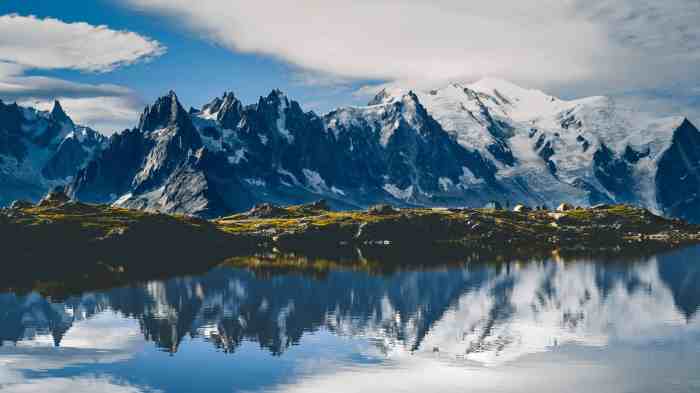
The majestic Alps, a breathtaking landscape sculpted by time and nature, face a complex future. As the 21st century unfolds, the challenges and opportunities facing this iconic mountain range are intertwined, demanding a thoughtful and proactive approach to ensure its continued vibrancy and sustainability.
Climate Change and Its Impact
Climate change poses a significant threat to the Alps, impacting its glaciers, ecosystems, and local communities. Rising temperatures have accelerated glacier melt, leading to a decline in snow cover and water resources. This affects water availability for agriculture, hydropower generation, and tourism.
Furthermore, rising temperatures and changing precipitation patterns increase the risk of natural disasters like floods, landslides, and wildfires, threatening infrastructure and human safety.
Sustainable Tourism Development
Tourism is a vital economic driver for the Alps, but its rapid growth can put pressure on the environment and local communities. To ensure a sustainable future, the region is embracing responsible tourism practices. This includes promoting eco-friendly accommodation, encouraging sustainable transportation options, and supporting local businesses.
By promoting responsible tourism, the Alps can attract visitors while minimizing its environmental footprint.
Cultural Preservation and Innovation
The Alps are home to a rich tapestry of cultures, traditions, and languages. As the region faces globalization and modernization, preserving its unique heritage is crucial. Initiatives are underway to promote traditional crafts, revitalize local languages, and safeguard cultural practices.
Additionally, the Alps are embracing innovation in various sectors, from renewable energy and sustainable agriculture to technology and education. By fostering innovation while respecting tradition, the region can create a dynamic and thriving future.
Examples of Sustainable Initiatives
- Alpine Convention:This international agreement, signed by countries bordering the Alps, aims to promote sustainable development in the region. It focuses on environmental protection, sustainable tourism, and cultural preservation.
- Green Tourism Certification:Several organizations offer certifications for hotels, restaurants, and other businesses that meet environmental and social sustainability standards. These certifications help tourists identify and support eco-friendly options.
- Renewable Energy Projects:Many Alpine communities are investing in renewable energy sources like solar and hydropower, reducing their reliance on fossil fuels and promoting energy independence.
- Local Food Initiatives:The Alps are known for their culinary traditions. Initiatives are promoting local food production, supporting farmers, and promoting the consumption of regional specialties, contributing to a sustainable food system.
The Alps: A Destination for Adventure, Culture, and Inspiration
The future of the Alps holds immense promise. By embracing sustainability, innovation, and cultural preservation, the region can continue to be a destination for adventure, culture, and inspiration. From breathtaking landscapes and thrilling outdoor activities to rich cultural heritage and charming towns and villages, the Alps offer a unique and unforgettable experience.
So you’re planning a trip to the Alps and trying to decide which of the Top 30 Places to visit will make the cut? Maybe you’re looking for something a little different, something a bit more adventurous, like the beautiful landscapes of New Zealand.
Check out this list of the Top 10 Places To Visit in New Zealand for some inspiration. Then, get back to your Alps list – you’ve got a lot of breathtaking scenery to explore!
The region’s commitment to sustainability ensures that its natural beauty and cultural treasures will be preserved for generations to come.
Last Point
As you journey through the Alps, you’ll be captivated by the breathtaking landscapes, rich history, and warm hospitality. From the thrill of skiing down pristine slopes to the serenity of hiking through alpine meadows, every moment in the Alps is an unforgettable experience.
So, pack your bags, grab your hiking boots, and get ready to embark on an adventure that will stay with you forever.
Query Resolution
What’s the best time of year to visit the Alps?
The best time to visit the Alps depends on your interests. Summer offers perfect hiking and outdoor activities, while winter brings world-class skiing and snowboarding. Spring and fall offer milder temperatures and fewer crowds.
How much does it cost to travel in the Alps?
Travel costs in the Alps can vary depending on your budget and travel style. Accommodation, transportation, and activities can range from budget-friendly to luxurious. It’s best to plan your trip in advance and set a budget.
What are some must-try dishes in the Alps?
Some must-try dishes in the Alps include raclette, fondue, and rösti. These traditional dishes feature local ingredients and flavors that are unique to the region.

